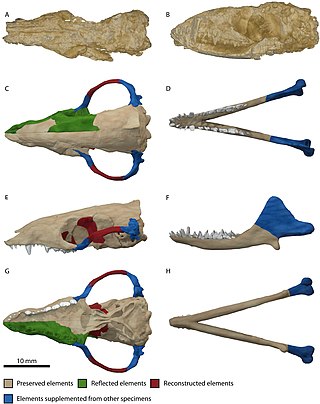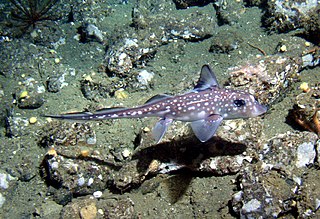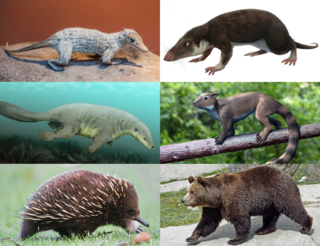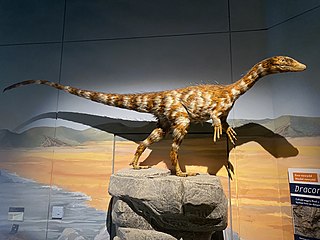
Morganucodon is an early mammaliaform genus that lived from the Late Triassic to the Middle Jurassic. It first appeared about 205 million years ago. Unlike many other early mammaliaforms, Morganucodon is well represented by abundant and well preserved material. Most of this comes from Glamorgan in Wales, but fossils have also been found in Yunnan Province in China and various parts of Europe and North America. Some closely related animals (Megazostrodon) are known from exquisite fossils from South Africa.

Chimaeras are cartilaginous fish in the order Chimaeriformes, known informally as ghost sharks, rat fish, spookfish, or rabbit fish; the last three names are not to be confused with rattails, Opisthoproctidae, or Siganidae, respectively.

Mammaliaformes is a clade that contains the crown group mammals and their closest extinct relatives; the group radiated from earlier probainognathian cynodonts. It is defined as the clade originating from the most recent common ancestor of Morganucodonta and the crown group mammals; the latter is the clade originating with the most recent common ancestor of extant Monotremata, Marsupialia, and Placentalia. Besides Morganucodonta and the crown group mammals, Mammaliaformes includes Docodonta and Hadrocodium.

Thalassiodracon (tha-LAS-ee-o-DRAY-kon) is an extinct genus of plesiosauroid from the Pliosauridae that was alive during the Late Triassic-Early Jurassic (Rhaetian-Hettangian) and is known exclusively from the Lower Lias of England. The type and only species, is Thalassiodracon (Plesiosaurus) hawkinsii.

Leptonectes is a genus of ichthyosaur that lived in the Late Triassic to Early Jurassic. Fossils have been found in Belgium, Germany, Switzerland, Spain and the United Kingdom. The type species, L. tenuirostris, reached 4 metres (13 ft) long, while L. moorei reached 3 metres (9.8 ft) long; the largest species, L. solei, was approximately 5–6 metres (16–20 ft) long.

Morganucodonta is an extinct order of basal Mammaliaformes, a group including crown-group mammals (Mammalia) and their close relatives. Their remains have been found in Southern Africa, Western Europe, North America, India and China. The morganucodontans were probably insectivorous and nocturnal, though like eutriconodonts some species attained large sizes and were carnivorous. Nocturnality is believed to have evolved in the earliest mammals in the Triassic as a specialisation that allowed them to exploit a safer, night-time niche, while most larger predators were likely to have been active during the day.

Clevosaurus is an extinct genus of rhynchocephalian reptile from the Late Triassic and the Early Jurassic periods. Species of Clevosaurus were widespread across Pangaea, and have been found on all continents except Australia and Antarctica. Five species of Clevosaurus have been found in ancient fissure fill deposits in south-west England and Wales, alongside other sphenodontians, early mammals and dinosaurs. In regards to its Pangaean distribution, C. hadroprodon is the oldest record of a sphenodontian from Gondwana, though its affinity to Clevosaurus has been questioned.

The Blue Lias is a geological formation in southern, eastern and western England and parts of South Wales, part of the Lias Group. The Blue Lias consists of a sequence of limestone and shale layers, laid down in latest Triassic and early Jurassic times, between 195 and 200 million years ago. The Blue Lias is famous for its fossils, especially ammonites.
Trioracodon is an extinct genus of Late Jurassic to Early Cretaceous eutriconodont mammal found in North America and the British Isles. It was named in 1928
Paleontology or palaeontology is the study of prehistoric life forms on Earth through the examination of plant and animal fossils. This includes the study of body fossils, tracks (ichnites), burrows, cast-off parts, fossilised feces (coprolites), palynomorphs and chemical residues. Because humans have encountered fossils for millennia, paleontology has a long history both before and after becoming formalized as a science. This article records significant discoveries and events related to paleontology that occurred or were published in the year 2011.
Paceyodon is an extinct genus of morganucodontan mammaliaform from Early Jurassic deposits of southern Wales, United Kingdom. Paceyodon is known from an isolated molariform that is significantly larger than any morganucodontan molariform yet discovered. It was collected in the Pant Quarry, Vale of Glamorgan. It was first named by William A. Clemens in 2011 and the type species is Paceyodon davidi.
Purbeckodon is an extinct genus of mammaliaforms, possibly belonging to Morganucodonta, that is known from Early Cretaceous deposits of southeastern Dorset, England. It was collected in the Purbeck Limestone Group of Dorset. It was first named by Percy M. Butler, Denise Sigogneau-Russell and P. C. Ensom in 2011 and the type species is Purbeckodon batei.

Anningasaura is an extinct genus of basal plesiosaur. It is known from a single type species, A. lymense, discovered in Early Jurassic rocks of Lyme Regis in the United Kingdom.
Doris Mary Kermack FLS was a British paleontologist and marine zoologist at Imperial College London. She completed her PhD thesis entitled 'The anatomy and physiology of the gut of Arenicola marina L.' at University College London in 1953. In 1988 she was awarded the Linnean Gold Medal for outstanding service to the society. She had two sons with her husband and fellow paleontologist Kenneth Kermack.

Dracoraptor is a genus of coelophysoid dinosaur that lived during the Hettangian stage of the Early Jurassic Period of what is now Wales dated at 201.3 ± 0.2 million years old.
Wareolestes rex is a mammaliaform from the Middle Jurassic (Bathonian) rocks of England and Scotland. It was originally known from isolated teeth from England, before a more complete jaw with teeth was found in the Kilmaluag Formation of Skye, Scotland.
Denise Sigogneau-Russell is a French palaeontologist who specialises in mammals from the Mesozoic, particularly from France and the UK. She is currently based at the Muséum National d'Histoire Naturelle.
Storchodon is an extinct genus of morganucodont mammaliaforms from the Late Jurassic (Kimmeridgian) of Germany. Its only species is Storchodon cingulatus, which is known exclusively from a single upper molar found at the Süntel Formation of Lower Saxony.
Indotherium is an extinct genus of mammaliaforms that lived in what is now India during the Early Jurassic. It contains one species, I. pranhitai, which is known from two upper molar teeth found in the Kota Formation of Telangana. When it was first described, it was assigned to the paraphyletic group "Symmetrodonta", but later studies have reinterpreted it as a possible member of the family Morganucodontidae.

Palaeontology in Wales is palaeontological research occurring in Wales.
















